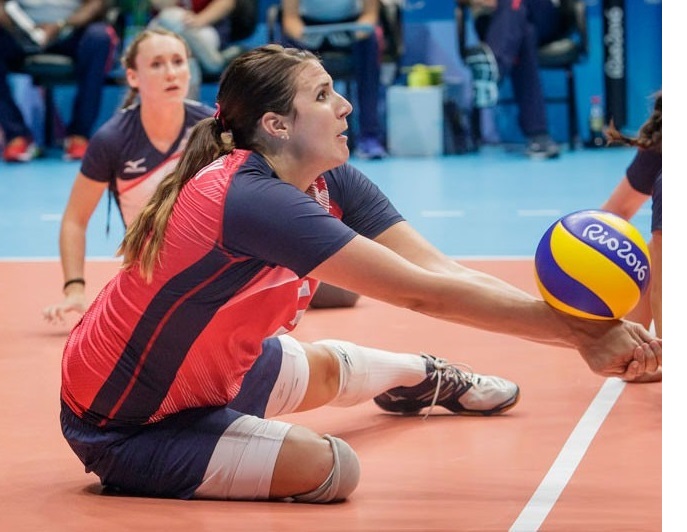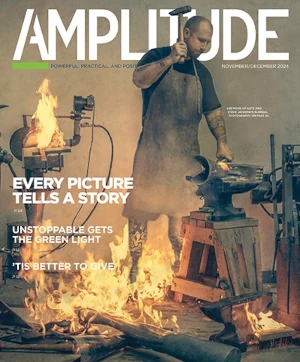Katie Holloway battled her way to a gold medal in 2016. But that was only the beginning of an even tougher fight.
After finally breaking through to win Paralympic gold in 2016, Katie Holloway was beyond stoked. She and her teammates on the U.S. women’s sitting volleyball team had ended eight years of frustration and finally topped their archrivals from China, to whom they’d lost the Paralympic championship match in both 2008 and 2012.

It was a triumphant moment marked by celebratory tears on the podium. But you have couldn’t have blamed Holloway if she wept for another reason upon receiving her medal bonus from the US Olympic Committee, or USOC (as the governing body was then known). She and her teammates each made $5,000 for bringing home gold. Meanwhile, their able-bodied counterparts on the Olympic men’s and women’s volleyball teams earned $10,000 apiece—twice as much—for winning bronze.
It’s not that Holloway begrudged the Olympians their reward. On the contrary, she knew those athletes deserved every penny of their bonus and then some. She understood how hard they worked and how much they sacrificed, because she and every Paralympian worked just as hard. But they got rewarded less handsomely for the same effort and the same accomplishments.
The gap was widest at the highest level of achievement. Olympic athletes in 2016 received a $25,000 bonus for winning a gold medal, versus the Paralympians’ $5,000 bonus—a fivefold difference.
That didn’t seem fair, to say the least. Holloway, as a member of the USOC Athletes’ Advisory Council (AAC), was in a position to call out the injustice and try to do something about it, but the initial response was less than encouraging. As she recalls: “The chief of sports performance told me, ‘Paralympians generate less than 1 percent of the [USOC’s] revenue, and we’re already paying you 11 or 12 percent of the overall pie. We can’t justify spending more on you than we already do.’”
It would take two years of intense effort to correct this egregious insult to adaptive athletes. Holloway was hardly alone in the fight, but she was right on the front lines. And when the USOC finally relented in 2018 and raised Paralympic medal compensation to the same level as Olympic bonuses, Holloway felt more exhausted than exhilarated.
“At every step of the way I felt so severely defeated,” she says. “It just took so much effort and energy to carry it forward.”
Nine months after achieving equitable compensation, adaptive athletes gained equal billing on the marquee when the USOC renamed itself the US Olympic and Paralympic Committee (USOPC). Two months after that change, Paralympic athletes expressed their gratitude by choosing Holloway to serve as Team USA’s flag-bearer for the opening ceremonies of the 2019 Parapan American Games.
The US Paralympians who compete next year in Tokyo will be the first to enter the Games as full equals to their Olympic teammates. Holloway, a right below-knee amputee, has never told the whole story of how it happened—until now. It begins in the immediate afterglow of Rio 2016, when Holloway attended a post-Games assembly in her capacity as AAC representative.
This conversation is edited for clarity:
Walk me back to the beginning of when Paralympic athletes first began talking about pay equity.
That conversation had been going on long before I came into positions where I was representing other athletes on the Advisory Council. For me personally, it started right after the Rio Paralympics in September of 2016. We have a general assembly every year with all the US Olympic and Paralympic athlete representatives from various boards, including the Athlete’s Advisory Council, which is what I had been on.
We had gotten wind that the key USOC executives had earned increased bonuses because the athletes, both Olympics and Paralympics, did so well in Rio. That generated some uproar in the AAC, because we hadn’t seen an increase in our medal bonuses in a long time. So the Olympians were generating a lot of heat in the front of the room, saying, “We need an increase in our gold medal bonus.” Meanwhile I’m in the back of the room, having a one-on-one with Rick Adams, who at that time had just been named chief of Paralympics. And I was telling him, “Hold on, we’d like to talk about equity. How can we get that into the conversation?” And at the time he was like, “I don’t know, maybe we can get donors to equal out the medal money.” Because the discussion in the front of the room was already getting loud, and if I had tried to insert myself into that and say, “Excuse me, you know what’s really unfair? Our bonuses aren’t equal,” that wasn’t going to go very well.
So you needed to pick your spot.
I think Paralympians have done that for a long time. We’ve learned that we have to be extremely strategic. We have to be very mindful and advocate for ourselves in a way that doesn’t take away from the Olympic athletes. We can’t make it an us-versus-them. And that’s a constant thing. We are constantly dancing around this idea, and we’re being told by [USOC] leaders that the pie is only so big, and if our share increases then somebody else’s has to get smaller.
Flash-forward to December 2016, three months later. The USOC Board of Directors comes out with this announcement that they are increasing everyone’s bonuses by 50 percent, both Olympians and Paralympians. Numberswise, we went from a situation where Olympians made $25,000 for gold and Paralympians made $5,000, to having Olympians make $37,500 for gold and Paralympians were making $7,500 for gold. So if you’re doing the math, we went from making $20,000 less [than Olympians] to making $30,000 less. The difference got bigger.
And, oh man, the amount of disgust and frustration, the slap in the face. That decision was so incredibly disrespectful to all of us.



